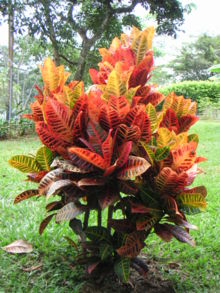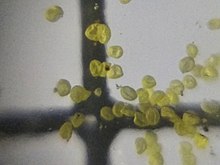| Codiaeum variegatum | |
|---|---|

| |
| Scientific classification | |
| Kingdom: | Plantae |
| Clade: | Tracheophytes |
| Clade: | Angiosperms |
| Clade: | Eudicots |
| Clade: | Rosids |
| Order: | Malpighiales |
| Family: | Euphorbiaceae |
| Genus: | Codiaeum |
| Species: | C. variegatum
|
| Binomial name | |
| Codiaeum variegatum | |
| Synonyms | |
|
Many including
| |
Codiaeum variegatum (fire croton, garden croton, or variegated croton; syn. Croton variegatum L.) is a species of plant in the genus Codiaeum, which is a member of the family Euphorbiaceae. It was described by Carl Linnaeus in 1753. It is native to Indonesia, Malaysia, Australia, and the western Pacific Ocean islands, growing in open forests and scrub.[2][3][4]
The garden crotons should not be confused with Croton, a cosmopolitan genus also in the Euphorbiaceae, containing more than 700 species of herbs, shrubs and trees.
Description[edit]
It is a tropical, evergreen, monoecious shrub growing to 3 m (9.8 ft) tall and has large, thick, leathery, shiny evergreen leaves, alternately arranged, 5–30 cm (2.0–11.8 in) long and 0.5–8 cm (0.20–3.15 in) broad. The leaf blades can, for example, be ruler-lanceolate, oblong, elliptic, lanceolate, ovate inverted, ovate spatulate, or violin-shaped and coloured green, yellow, or purple in various patterns, depending on the variety. The petiole has a length of 0.2 to 2.5 cm. The inflorescences are long racemes, 8–30 cm (3.1–11.8 in) long, with male and female flowers on separate inflorescences; the male flowers are white with five small petals and 20–30 stamens, pollens are oval approximately 52x32 microns in size. The female flowers are yellowish, with no petals. The flowering period is usually in early autumn. The fruit is a capsule 9 mm (0.35 in) in diameter, containing three seeds that are 6 mm (0.24 in) in diameter. When cut, stems bleed a milky sap like many of the Euphorbiaceae.[2][3][5]

Cultivation[edit]

In tropical climates, crotons make attractive hedges and potted patio specimens, valued for their striking foliage. They only survive outdoors where temperatures do not normally drop below 10 to 13 °C (50 to 55 °F) in winter; colder temperatures can cause leaf loss.[3] In colder climates, the plants are grown in greenhouses or as house plants. The cultivated garden crotons are usually smaller than the wild plant, rarely over 1.8 m (5.9 ft) tall, and come in a wide diversity of leaf shapes and colours. They are sometimes grouped under the name Codiaeum variegatum var. pictum (Lodd.) Müll. Arg.,[3] though this is not botanically distinct from the species and usually treated as a synonym of it.[2]
Cultivars[edit]
The several hundred cultivars are selected and bred for their foliage. Depending on the cultivar, the leaves may be ovate to linear, entire to deeply lobed or crinkled, and variegated with green, white, purple, orange, yellow, red, or pink. The colour patterns may follow the veins or the margins, or be in blotches on the leaf. Popular cultivars include 'Spirale', which has spirally twisted red and green leaves; 'Andreanum', which has broadly oval yellow leaves with gold veins and margins; 'Majesticum', which has pendulous branches, with linear leaves up to 25 cm (9.8 in) long with midrib veins yellow maturing to red; and 'Aureo-maculatum', which has leaves spotted with yellow.[3]
Toxicity[edit]
As with many of the Euphorbiaceae, the sap can cause contact dermatitis in some people.[6] The bark, roots, latex, and leaves are poisonous.[7] The toxin is the chemical compound 5-desoxyingenol.[7] The plant contains an oil which is violently purgative and is suspected of being a carcinogen.[8] Consumption of the seeds can be fatal to children.[8]
Gallery[edit]
-
C. variegatum in Miyako-jima, Okinawa Prefecture, Japan
-
C. variegatum in Miyako-jima, Okinawa Prefecture
-
Completely yellow leaves on a specimen in Kolkata, India
-
Croton 'Petra' in a botanical garden
-
Narrow-leaved variety
-
A green-yellow variegated variety
-
Female flowers
-
Young fruits
References[edit]
- ^ G. Nicholson Ill. Dict. Gard. 1: 352 1885
- ^ a b c Flora of China: Codiaeum variegatum
- ^ a b c d e Huxley, A., ed. (1992). New RHS Dictionary of Gardening 1: 665. Macmillan.
- ^ "Codiaeum variegatum var. Moluccanum | Atlas of Living Australia". Archived from the original on 2015-10-02. Retrieved 2015-06-15.
- ^ Bingtao Li & Michael G. Gilbert: Codiaeum in the Flora of China , Volume 11, 2008, p. 268
- ^ Occupational contact dermatitis due to croton (Codiaeum variegatum (L.) A. Juss var. pictum (Lodd.) Muell. Arg.). Sensitization by plants of the Euphorbiaceae. Contact Dermatitis 1977 Dec. 3(6): 289-92. abstract.
- ^ a b National Tropical Botanical Garden Codiaeum variegatum (Euphorbiaceae) Archived 2011-07-19 at the Wayback Machine
- ^ a b "Croton (Codiaeum Variegatum)". Nova Scotia Museum. Archived from the original on 2017-11-07.







